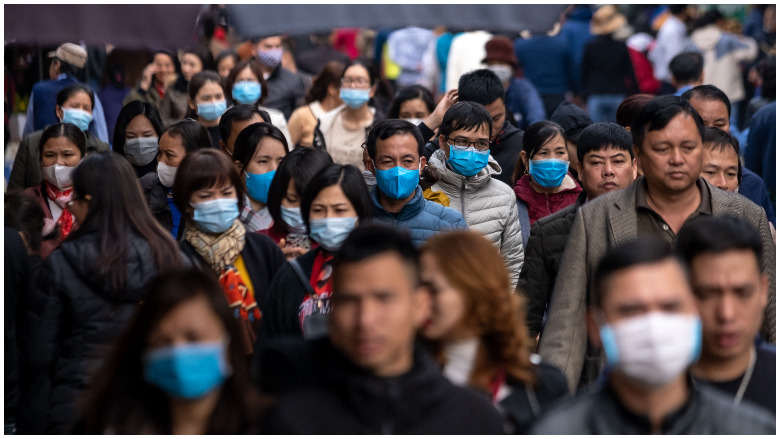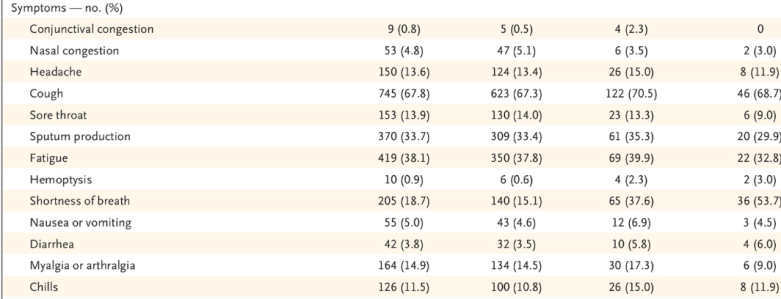
With the COVID-19 coronavirus fundamentally altering life around the world, many people are wondering whether their symptoms match coronavirus. Among those questions: Is a sore throat an early symptom of coronavirus?
The answer: It can be, but it’s not the most common symptom (you can see a breakdown later in this article). Coronavirus diagnosis can be tricky because the symptoms are, in many cases, very similar to the flu or a common cold. In addition, it’s hard to get testing in many jurisdictions even if you’ve traveled overseas. There’s not a known cure for coronavirus anyway, so if you think you have it, consult with your primary care doctor. Many doctors are advising people to try to manage their symptoms at home if possible. Boost your immunity. Drink a lot of fluids. Rest. However, again: Consult your own doctor for medical advice. Most people who get coronavirus will recover, but survivors have described a very vicious battle with a flu-like illness.
Let’s tease out how common a sore throat is though in studies of coronavirus, with the recognition that people’s bodies handle the virus different ways. Not everyone has the same symptoms at the same stages.
“The most common symptoms of COVID-19, the disease caused by the new coronavirus, are fever, cough and shortness of breath,” according to John Hopkins Medicine. “Some patients also have body aches, runny nose, sore throat or diarrhea. If you have a sore throat and think you have been exposed to the new coronavirus, contact a health care provider by phone and discuss your risk.”
Here’s what you need to know:
Yes, a Sore Throat Can Be a Sign of Coronavirus, But It’s Not the Most Common One
First of all, just because you have a sore throat doesn’t mean you have coronavirus. You might have the flu, a common cold, or something like strep throat. Your doctor is better equipped to tell you that (don’t take medical advice over the Internet!) But credible research studies and governmental sites have outlined the common symptoms for coronavirus. Sore throat is among them. Also be aware that the virus has an incubation stage (symptoms appear between 2-14 days) and the symptoms themselves can take time to worsen (even 8 days or more). However, again, most people recover from COVID-19.
The article Clinical Characteristics of Coronavirus Disease 2019 in China was published in the New England Journal of Medicine. That article noted, “During the first 2 months of the current outbreak, Covid-19 spread rapidly throughout China and caused varying degrees of illness. Patients often presented without fever, and many did not have abnormal radiologic findings.” Thus, although fever is often cited as a leading indicator of coronavirus, an absence of a fever does not mean that you don’t have it, either.
However, this study did find that the most common coronavirus symptoms were fever and cough.
“The median incubation period was 4 days (interquartile range, 2 to 7). The median age of the patients was 47 years (interquartile range, 35 to 58); 0.9% of the patients were younger than 15 years of age. A total of 41.9% were female. Fever was present in 43.8% of the patients on admission but developed in 88.7% during hospitalization,” the researchers reported. “The second most common symptom was cough (67.8%); nausea or vomiting (5.0%) and diarrhea (3.8%) were uncommon. Among the overall population, 23.7% had at least one coexisting illness (e.g., hypertension and chronic obstructive pulmonary disease).”
The study found that 13.9 percent of patients had a sore throat. Here’s the list of symptoms with percentages found in that research study:

Emerging 2019 Novel Coronavirus (2019-nCoV) Pneumonia is another research study that broke down the percentages of symptoms in Chinese patients with the virus.
That study of coronavirus patients found that only 6 percent had a sore throat. The most common symptom was fever, which was reported by 96 percent of patients, following by a cough (47 percent), a little phlegm (20 percent), myalgia or fatigue (31 percent), mild headache and dizziness (16 percent), mild dyspnea or chest paint (14 percent), loss of appetite (18 percent), diarrhea (10 percent), stuffy or runny nose (4 percent) and nausea and vomiting, 6 percent.
Here’s the symptom chart from that study:

According to Harvard Medical School, “some people infected with the virus have no symptoms. When the virus does cause symptoms, common ones include low-grade fever, body aches, coughing, nasal congestion, and sore throat. However, COVID-19 can occasionally cause more severe symptoms like high fever, severe cough, and shortness of breath, which often indicates pneumonia.”
According to the Centers for Disease Control and Prevention, coronavirus symptoms “may appear 2-14 days after exposure (based on the incubation period of MERS-CoV viruses).” The site lists the most common symptoms as:
Fever
Cough
Shortness of breath
According to Al-Jazeera, some people get a sore throat with coronavirus because of how the virus typically enters the body; “Once you have breathed it in, the virus quickly travels to the back of your throat and nose…This destruction of cells in your nose and throat leads to the dry cough and sore throat.”
The Australian government explains, “If you develop symptoms (fever, a cough, sore throat, tiredness or shortness of breath) within 14 days of leaving country or region that is at higher risk for COVID-19, or within 14 days of last contact of a confirmed case, you should arrange to see your doctor for urgent assessment.”
In general, according to the National Foundation for Infectious Diseases, coronaviruses (of which there are many), can cause these symptoms:
runny nose
headache
cough
sore throat
fever
Loss of taste and smell and red rimmed eyes have also emerged as possibly symptoms of COVID 19.
Sometimes the virus leads to pneumonia, which is when the virus gets more serious and can require hospitalization.
According to Stat News, one of the earlier cases of coronavirus involved a man in Germany. On January 24, he “developed a sore throat, chills, and muscle soreness, with a fever and cough arriving the following day.” By January 27 he was better. He tested positive for coronavirus.
How do I know if I have COVID-19 or the regular flu? Harvard Medical School advises: “COVID-19 often causes symptoms similar to those a person with a bad cold or the flu would experience. And like the flu, the symptoms can progress and become life-threatening. Your doctor is more likely to suspect coronavirus if: you have respiratory symptoms and you recently traveled to countries with ongoing community spread of the COVID-19 virus, including China, Iran, Italy, Japan, South Korea, or you have been exposed to someone suspected of having COVID-19, or there has been community spread of the virus that causes COVID-19 in your area.
What is the incubation period? “Because this coronavirus has just been discovered, the time from exposure to symptom onset (known as the incubation period) for most people has yet to be determined. Based on current information, symptoms could appear as soon as three days after exposure to as long as 13 days later. Recently published research found that on average, the incubation period is about five days,” says Harvard.
READ NEXT: Can You Get Coronavirus From Money?